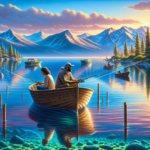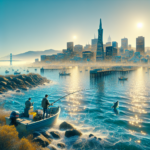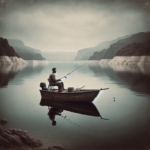Fishing in the St. Lawrence River: New York and Canada’s Border Waters

Introduction
Did you know that the St. Lawrence River, which forms part of the border between New York and Canada, is one of the most diverse and productive fishing areas in North America? This article will delve into the rich fishing opportunities available in these border waters, covering everything from the best fishing techniques and species information to top fishing spots and seasonal considerations. Whether you’re a seasoned angler or a novice looking to cast your first line, this guide will provide you with all the information you need to make the most of your fishing experience on the St. Lawrence River.
Fishing in the St. Lawrence River matters not only because of the variety of fish species available but also due to the unique experience it offers. The river’s vast ecosystem supports a wide range of fish, making it a prime location for anglers. Additionally, understanding the best techniques, gear, and times to fish can significantly enhance your success and enjoyment.
Background/Context
Historical or Cultural Significance
The St. Lawrence River has been a vital waterway for centuries, serving as a crucial route for trade and exploration. Indigenous peoples, such as the Iroquois, have fished these waters for generations, relying on the river’s bounty for sustenance. European settlers later recognized the river’s importance, and it became a key part of the fur trade and other economic activities. Today, the St. Lawrence River remains a significant cultural and economic resource, attracting anglers from around the world.
Geographical Overview
The St. Lawrence River stretches over 1,200 kilometers (750 miles) from Lake Ontario to the Atlantic Ocean, forming part of the border between New York and Canada. The river’s diverse ecosystem includes a variety of habitats, such as deep channels, shallow bays, and marshes, supporting a wide range of fish species. The climate in the region varies, with cold winters and warm summers, influencing the behavior and availability of fish throughout the year.
Key Points/Details
Fishing Techniques
Technique Overview
Several fishing techniques are effective on the St. Lawrence River, including fly fishing, trolling, and ice fishing. Each technique has its own set of advantages and is suited to different conditions and species.
When and Where to Use
Fly fishing is particularly effective in the river’s shallower areas and during the warmer months when fish are more active near the surface. Trolling is ideal for deeper waters and can be used year-round, while ice fishing is popular during the winter months when the river freezes over.
Recommended Gear
- Fly Fishing: A 9-foot, 5-6 weight fly rod, floating line, and a variety of flies, including nymphs and streamers.
- Trolling: A medium-heavy spinning or baitcasting rod, 20-30 lb test line, and a selection of lures such as crankbaits and spoons.
- Ice Fishing: A short, sturdy ice fishing rod, 6-8 lb test line, and ice jigs or live bait.
Species Information
Species Overview
The St. Lawrence River is home to a variety of fish species, including smallmouth bass, northern pike, walleye, muskellunge, and perch. Each species has its own habits and preferred habitats, making the river a diverse and exciting fishing destination.
Best Practices
- Smallmouth Bass: Use soft plastic baits or crankbaits near rocky structures and during the warmer months.
- Northern Pike: Target weedy areas with large spoons or spinnerbaits, especially in spring and fall.
- Walleye: Fish deeper waters with jigs or live bait, particularly during early morning or late evening.
- Muskellunge: Use large lures and fish near structures such as submerged logs or weed beds, primarily in late summer and fall.
- Perch: Use small jigs or live bait in shallow waters, especially during the spring and summer months.
Location Information
Top Fishing Spots
- Thousand Islands: This area offers numerous islands and channels, providing excellent fishing opportunities for bass, pike, and muskellunge.
- Lake St. Francis: Known for its walleye and bass fishing, this lake is a popular spot for anglers on both sides of the border.
- Ogdensburg: Located in New York, this area offers easy access to the river and is known for its diverse fish population.
- Montreal: The waters around Montreal are rich in fish species, making it a great spot for urban anglers.
Regulations and Licenses
Fishing regulations and license requirements vary between New York and Canada. Anglers must ensure they have the appropriate licenses for the waters they plan to fish. In New York, a fishing license is required for anyone over the age of 16. In Canada, anglers need a valid fishing license, which can be obtained online or at local retailers. Additionally, there are specific regulations regarding catch limits, size limits, and seasonal restrictions that must be followed to ensure sustainable fishing practices.
Seasonal Considerations
Seasonal Variations
Fishing conditions on the St. Lawrence River change throughout the year, affecting fish behavior and availability. In spring, fish are more active as they prepare for spawning, making it an excellent time for bass and pike fishing. Summer offers warm water temperatures and abundant food sources, leading to increased fish activity. Fall is a prime time for targeting larger species like muskellunge, while winter brings opportunities for ice fishing.
Best Times to Fish
- Spring: Early morning and late afternoon are ideal for bass and pike fishing.
- Summer: Fish during the cooler parts of the day, such as early morning or late evening.
- Fall: Midday can be productive for muskellunge and walleye.
- Winter: Ice fishing is best during the early morning or late afternoon.
Events and Tournaments
Event Overview
The St. Lawrence River hosts several fishing events and tournaments throughout the year, attracting anglers from around the world. Notable events include the Bassmaster Elite Series, which takes place in the Thousand Islands region, and local ice fishing derbies held during the winter months.
Preparation Tips
- Gear: Ensure you have the appropriate gear for the event, including rods, reels, and tackle.
- Practice: Spend time practicing your techniques and familiarizing yourself with the fishing spots before the event.
- Strategy: Develop a strategy based on the species targeted and the conditions expected during the event.
Tips and Best Practices
General Tips
- Always check local fishing regulations and obtain the necessary licenses before heading out.
- Pay attention to weather conditions and adjust your fishing techniques accordingly.
- Use a fish finder to locate schools of fish and identify underwater structures.
- Practice catch and release to help preserve fish populations and ensure sustainable fishing.
Avoid Common Mistakes
- Avoid using the wrong gear for the species you’re targeting; ensure your tackle is appropriate for the fish you’re after.
- Don’t ignore local fishing reports and advice from experienced anglers; they can provide valuable insights.
- Avoid fishing in heavily trafficked areas; seek out quieter spots for a more productive experience.
Advanced Techniques
- Master the art of using different lures and baits to match the conditions and fish behavior.
- Learn to read the water and identify potential fish-holding structures such as drop-offs, weed beds, and submerged logs.
- Experiment with different retrieval speeds and patterns to trigger strikes from hesitant fish.
Gear and Equipment Recommendations
Essential Gear
- Fishing rod and reel appropriate for the species you’re targeting.
- Fishing line with the appropriate strength and type for your chosen technique.
- A variety of lures and baits, including soft plastics, crankbaits, and live bait.
- Tackle box with essential tools such as pliers, line cutters, and hooks.
- Fish finder or depth sounder to locate fish and underwater structures.
Optional Gear/Upgrades
- Polarized sunglasses to reduce glare and improve visibility in the water.
- Fishing kayak or boat for accessing remote fishing spots.
- Portable fish cleaning station for preparing your catch on-site.
- High-quality fishing apparel, including waterproof jackets and waders.
Where to Buy or Rent
Local bait and tackle shops in towns along the St. Lawrence River offer a wide range of fishing gear and equipment. Additionally, online retailers such as Bass Pro Shops and Cabela’s provide extensive selections and convenient shipping options. For those looking to rent equipment, many local outfitters offer rental services for boats, kayaks, and fishing gear.
Safety and Conservation
Safety Tips
- Always wear a life jacket when fishing from a boat or kayak.
- Check weather forecasts before heading out and be prepared for sudden changes in conditions.
- Carry a first aid kit and know basic first aid procedures.
- Be aware of local wildlife and take precautions to avoid encounters with potentially dangerous animals.
Conservation Practices
- Practice catch and release to help maintain healthy fish populations.
- Follow local fishing regulations, including size and catch limits.
- Avoid disturbing natural habitats and be mindful of your impact on the environment.
- Dispose of fishing line and other waste properly to prevent harm to wildlife.
Planning Your Trip
Accommodations
There are numerous accommodation options near the St. Lawrence River, ranging from campgrounds and RV parks to hotels and vacation rentals. Popular choices include:
- Thousand Islands Campground: Offers tent and RV sites with easy access to prime fishing spots.
- Riveredge Resort: Located in Alexandria Bay, this resort provides comfortable rooms and amenities for anglers.
- Holiday Inn Express & Suites: Situated in Ogdensburg, this hotel offers modern accommodations and convenient access to the river.
Travel Tips
- Plan your route in advance and consider using a GPS or map app for navigation.
- Check border crossing requirements if traveling between New York and Canada.
- Pack essential items such as fishing gear, clothing, food, and water for your trip.
- Consider renting a car or boat if you don’t have your own transportation.
Additional Activities
In addition to fishing, the St. Lawrence River region offers a variety of activities for visitors, including:
- Boating: Explore the river’s many islands and channels by boat or kayak.
- Hiking: Enjoy scenic trails in nearby parks such as the Thousand Islands National Park.
- Wildlife Watching: Observe local wildlife, including birds, deer, and beavers, in their natural habitats.
- Historical Sites: Visit historical landmarks such as Boldt Castle and Fort Henry.
Frequently Asked Questions (FAQs)
Do I need a fishing license to fish on the St. Lawrence River?
Yes, a fishing license is required for both New York and Canadian waters. Ensure you have the appropriate license for the area you plan to fish.
What are the best times of year to fish on the St. Lawrence River?
Spring and fall are generally the best times for fishing, as fish are more active during these seasons. However, summer and winter also offer excellent opportunities for different species and techniques.
Can I fish from the shore, or do I need a boat?
You can fish from the shore in many areas along the St. Lawrence River. However, having a boat or kayak can provide access to more remote and productive fishing spots.
What species of fish can I catch on the St. Lawrence River?
The river is home to a variety of species, including smallmouth bass, northern pike, walleye, muskellunge, and perch.
Are there any fishing tournaments on the St. Lawrence River?
Yes, several fishing tournaments are held on the river throughout the year, including the Bassmaster Elite Series and local ice fishing derbies.
Conclusion
The St. Lawrence River offers a unique and rewarding fishing experience for anglers of all skill levels. With its diverse fish species, varied habitats, and rich cultural history, the river provides endless opportunities for exploration and enjoyment. By following the tips and best practices outlined in this guide, you can make the most of your fishing adventure on the St. Lawrence River. So grab your gear, head to the river, and start making memories that will last a lifetime.




